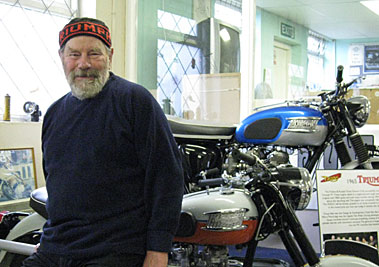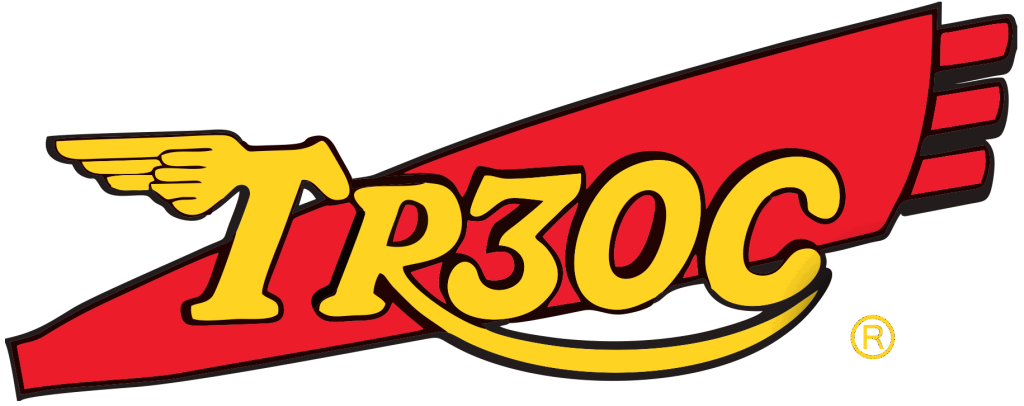Bill Crosby 1932-2020.
As most of you will know by now, Bill Crosby passed away on 29th March 2020, our thoughts and best wishes are with his family.
Much has been written about Bill, whose support and passion for the TR3OC was legendary, to write a tribute to a man who gave so freely of his time and expertise is somewhat difficult, so by way of a most fitting tribute below is an article from Triple Echo written by Bill himself about the restoration of the P1, which illustrates perfectly Bill’s character and commitment to the TR3OC
RIP Bill.
Peter Nicholson
Fire of London
by Bill Crosby
Neil Payne told me he had located the P1 and would see if the Trident & Rocket 3 Owners Club would back the project. I assured him that if the Club didn’t – I would! Next, the Club agreed and Neil and Kieron Carvell collected it and I think it went to Kieron’s garage, where they split it, photographing as they went.
The first I saw of it were the step-by-step strip-down photos and I was asked, “What do you think?” Me, I’m a sucker for prototypes! When it was delivered here what I found were crank cases, crank, rods, pistons, barrel, head, timing cover, the oil pump and sump plate; but no gearbox or primary drive, and not even a photo to go on.
The liners had turned in the alloy barrels and shredded the con rods. At a quick glance I assumed that, due to the shape, they were T100’s and, after acquiring a new set, realised my error. Too long – they were in fact Trident length but with a much slimmer big end eye (as per pre-unit). To overcome this set back I decided to lighten Triple rods to fit the job, i.e. the larger latter rods would foul the bottoms of the barrels. The P1 utilises pre-unit 500 pistons. These were put back in the bike but with new rings.
Not having dismantled the engine ourselves was a setback, as we had no knowledge of where, when or how. So we had to assemble dry, disassemble and reassemble the engine so that we could check that we were on the right lines. After talking to Harry Woolridge we realised that the primary drive was the “Achilles heel”. Originally a train of constant mesh gears that ran on needle rollers, which got too hot and screamed, shredding the clutch plate tangs. So we decided not to go that route but to try to install a T150 diaphragm clutch lifted by rod and a three ball mechanism, as per the twins.
In the meantime, Neil, Kerion and Co. were scouring the countryside for genuine parts to make a 1965 T120 rolling chassis. I came up with a few bits and the lads collected, assembled and delivered (stoved and painted) the rolling chassis, complete with box of bits to assemble.
Our remit from Neil was “It must be original”. I should admit now that where I use an “I”, it should be a “we”. Skinny Dave (David Whitfield) was the pair of hands and, given a challenge, a very adequate engineer. He milled thous off the primary chaincase until it fitted. WE got the main shaft bored for a push rod; he machined gears until they matched – quite a few nights work. We then fitted a belt drive. The belt was a good idea because it took little alignment. The crank case lug was missing – cut off – so a donor lug was replaced; the engine had to be completed with head and barrel fitted, due to having through-studs from crank case to rockers bowes. This proved to be a headache when we came to fit it in the ’65 frame. It wouldn’t fit! That blasted lug at the rear stopped it dropping into place. “It must be as ORIGINAL” insisted Neil. Had we used a 1966 frame with detachable front engine plates, no problem. “It must be as ORIGINAL”. We tried all ways to fit the engine, including a length of Brendan Ryan’s 2×2 timber and I must admit to cheating in the end. I bent the front engine lug out of the way, then bent it back: “ORIGINAL N.P.” The engine in the frame, the cycle parts fitted, then the carbs presented a problem.
The Club had announced that the P1’s first outing under its own power would be at Beezumph 6, which was approaching fast. We were running out of time. I couldn’t find chopped monoblocs the right size, and we were guessing as to what and how the factory arranged the carbs. From pictures they were monoblocs, se we elected to chop the two left and right and feed a float chamber to the centre one: seemed an ORIGINAL N.P. idea at the time, and as we possessed no drawings or photos of any linkage, we decided to fit a 3 into 1 cable set up.
That done, next was the ignition. The original (we think) was a set of points in the timing cover, triggering a triple distributor. We only had a body, no guts. So we fabricated a cap and HT leads (looks good). In the P1 timing cover, the points housing is smaller than the production Triples, as per the twins. So to fit the Boyer unit we had decided upon it meant machining the stator plate, screws etc, to fit. The HT coils were mounted under the seat with the rest of the Boyer unit.
We now had the engine fitted and ignition in place. All we had to do was start it, and one of Neil’s many visits to my shop was an ideal time to fire it up. We gave Neil a camera to recall the rebirth, and my son Mark kicked and kicked and kicked. A few plops, we tickled and kicked, tickled a kicked then …. plop, your bike caught fire!
A result of the excess fuel from tickling plus a spit back, I have never blown so hard. Neil had kittens and forgot the camera, but I’m pleased to say we blew it out! We did get it started and after a few tweaks, it sounded great.
The Cadwell debut was very near and the clutch was impossible to free with the clutch lever. To lift the Trident diaphragm proved too heavy for the three-ball mechanism. Cadwell beat us. Your President, Mr “Triple” Williams rode it around the paddock and the top straight a couple of times for photographs. That sound: “ORIGINAL N.P.”. Les was the only one to ride the P1.
We have since removed the Triple clutch and replaced it with a smaller diaphragm clutch as fitted to two-stroke scramblers, with help from Fluff Brown of AJS Motorcycles and also Arthur Somerscales who got a biker mate to make a new mainshaft. We machined another set of gears, using a Daytona engine sprocket to make up for the smaller clutch sprocket, remade the primary chain case and it all worked out OK!
As “ORIGINAL” unless someone knows better…..
As a postscript, this Summer Mick Duckworth did a road test and confirmed the gear ratios were perfect!

